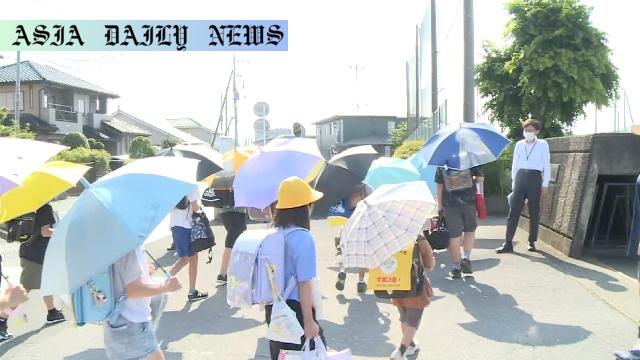Heatwave continues across Japan with record-breaking temperatures and rising health concerns.
Heatwave drives temperatures to 35°C+ across Japan.
Rainy season ends earlier in Kagoshima’s Amami region.
Heatstroke claims lives; alerts issued for Okinawa & other regions.
Safety measures include hydration, rest & air-conditioning.
Unstable atmospheric conditions spark thunderstorms in Tohoku.

Record-Breaking Temperatures Sweep Across Japan
Japan continues to endure a relentless heatwave, causing temperatures to soar to unprecedented highs across the country. For three consecutive days, areas have experienced extreme heat, with several locations recording daytime highs that exceeded 35°C. This ongoing phenomenon has been attributed to the dominance of a high-pressure system creating intense sunshine and stagnant atmospheric conditions. Prominent cities such as Tajimi, Gifu (36.9°C), and Kiryu, Gunma (36.7°C), saw some of the highest temperatures recorded in years. Furthermore, 56 observation points reported temperatures exceeding 35°C, while over two-thirds of Japan’s official weather stations logged temperatures surpassing the 30°C mark.
Earlier End to Rainy Season in Kagoshima’s Amami Region
Adding to the unusual weather pattern is the earlier-than-expected ending of the rainy season in the Amami region, located in Kagoshima Prefecture. Experts from the Meteorological Agency confirmed that it concluded ten days ahead of its historical average and three days earlier relative to last year. While the conclusion of the rainy season in Amami is a regional event, it reflects broader meteorological anomalies that are influencing the country at large, such as shifts in seasonal rain patterns and hotter-than-average summers. The lack of precipitation has further exacerbated the heat’s intensity.
Heatstroke Alerts and Rising Health Concerns
As temperatures climb to dangerous levels, the threat to public health becomes increasingly apparent. Over the past few days, fatal cases of heatstroke have tragically been reported. Health authorities have issued high-priority heat alerts, particularly for Okinawa’s main island and surrounding areas. Extreme weather conditions necessitate immediate precautions to avoid exhaustion, dehydration, or other heat-induced complications. Citizens and tourists are being advised to take proactive steps, including staying hydrated, taking periodic rests when outdoors, and utilizing cooling systems. Importantly, vulnerable groups such as the elderly, young children, and those with preexisting health conditions must exercise extra caution.
Unstable Atmospheric Conditions and Forecasted Thunderstorms
Interestingly, despite the country being gripped by widespread heat, certain regions like Tohoku and Kanto-Koshin are witnessing unstable atmospheric conditions marked by thunderstorm activity. Rain clouds are rapidly developing, indicating a stark contrast in weather dynamics. Officials have warned of potential lightning strikes and strong gusts, including tornadoes. Such erratic weather further underscores the atypical state of Japan’s climate, as various compounding elements add complexity to the forecast. Residents are advised to remain cautious and heed official warnings, particularly in areas prone to lightning incidents.
The Road Ahead: Proactive Measures Are Key
Japan’s enduring heatwave and evolving weather conditions underscore the importance of preparation and adaptability. As temperatures persist at hazardous levels, citizens must prioritize their well-being by recognizing early signs of heatstroke, maintaining hydration, and limiting outdoor exposure when temperatures peak. Urban planners and local governments may need to increase investments in cooling facilities, water distribution points, and weather-resilient urban designs to accommodate such heat extremes. Long-term, Japan must prepare for recurring high-temperature summers, attributed both to global climate change and localized weather anomalies.



Commentary
Understanding the Scope and Scale of Japan’s Heatwave
Japan’s current heatwave highlights a growing global concern regarding the impacts of extreme weather conditions. With temperatures exceeding comfort thresholds and daily records being shattered, this event is a sharp reminder of the urgent need to address weather-associated health risks. The direct consequences, such as fatalities from heatstroke and health advisories for vulnerable populations, should drive conversations about community resilience and emergency preventive measures. Citizens must recognize the gravity of extreme heat and adapt accordingly in the face of similar challenges in the future.
Linkages to Global Climate Trends
The earlier-than-expected end to the rainy season in southern Japan speaks volumes about the broader implications of climate shifts. A delay or acceleration in seasonal cycles often results in unpredictable weather phenomena—ranging from scorching heat to sudden thunderstorms. Such irregularities are not confined to Japan; nations worldwide are grappling with comparable patterns. This situation warrants global attention, encouraging scientific research that seeks to uncover the depths of our climate system. Furthermore, the role of anthropogenic (human-induced) factors in influencing these trends cannot be overlooked.
Staying Vigilant and Mitigating Future Risks
As we observe the continued impact of Japan’s heatwave, it becomes crucial to extract lessons from this experience. Enhanced weather monitoring, public awareness campaigns, and infrastructure updates designed to withstand temperature extremes could mitigate risks associated with future heatwaves. The situation also raises questions about how urban heat island effects—where metropolitan areas retain more heat than rural regions—can be minimized. Collaborative efforts between governments, local communities, and environmental researchers are essential for fostering sustainable solutions.